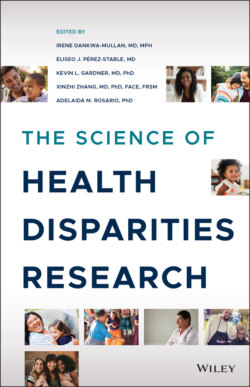Читать книгу The Science of Health Disparities Research - Группа авторов - Страница 40
2.6 How We Feed: Nutrition and Nutrition‐related Health Disparities
ОглавлениеNutrition‐related disparities are well documented, with low nutritional value foods and low‐quality diets more prevalent among disadvantaged than nondisadvantaged populations [54]. This could be related to food deserts and food insecurity, which are more likely to be concentrated in neighborhoods with a high proportion of minority and low‐income populations. According to the United States Department of Agriculture (USDA), food deserts include census tracts that are low‐income (i.e., where a portion of residents make below a threshold income) and low access (i.e., where a significant portion of the residents is far from a supermarket). The USDA defines food insecurity as “the limited or uncertain availability of nutritionally adequate and safe foods or limited or uncertain ability to acquire acceptable foods in socially acceptable ways” [55].
Residents of minority and low‐income neighborhoods have limited availability of affordable and healthy foods, and must rely on the nonhealthy/non‐nutritious foods available in their proximity or incur significant tangible (e.g., monetary) or intangible (e.g., long distance travel) costs to buy more expensive healthy options [56]. Low‐income neighborhoods have lower availability of fruits and vegetables and nutrient‐dense foods [56]. Such neighborhoods also include more small stores than large supermarkets. This is important because prices of staple food items such as milk, eggs, fruits, and vegetables are higher in small stores compared to large ones, with one study finding the difference ranging from 10% to 50% higher [56]. Smaller stores also have fewer fresh items and sell smaller units of packaged items than supermarkets, resulting in higher prices [56, 57]. One study estimated that a resident of a poor Black neighborhood lived 1.1 miles farther from the closest supermarket than a resident of a poor White neighborhood [57]. Further, low‐income neighborhoods have a high concentration of unhealthy food restaurants (e.g., fast food), thus adding to the limited availability of healthy food options [57]. As a result, and in contrast to the diet of higher‐income populations, the diet of low‐income populations generally costs less than a healthier, nutrient‐dense diet because it is of low nutritional value and low quality [54].
Disparities in intake of nutritious food are associated with disparities in health and well‐being. Populations whose diet is mostly of low nutritional quality experience poor dietary patterns, including low fruit and vegetable intake. They also experience lower levels of serum carotenoids and higher rates of obesity and high blood pressure, which are associated with diabetes, cardiovascular disease, and other chronic diseases [54, 56, 57]. Even after controlling for home food‐environment factors, an association persisted between neighborhood food‐environment factors such as food deserts and obesity [58].
Healthy, nutrient‐dense food is often neither available nor affordable in communities where health disparity populations live. Consequently, those populations experience a high prevalence of nutrition‐related diseases and conditions. Possible biological pathways linking nutritional stressors to health disparities include allostatic load and changes to the microbiome. Both pathways are responses to local inflammations caused by nutritional stressors, including inadequate intake of key nutrients or a high intake of calorie‐dense foods, such as frequent fast food meals. The hypothalamus, which plays a central role in regulating feeding and nutrition, is subject to modulation by local inflammatory events. Studies have shown that normal physiological control of feeding by the hypothalamus can be disrupted by local inflammation, some of which is influenced by high levels of dietary LCFA [4, 11]. This local inflammation blunts the response of the hypothalamus to leptin and insulin, thus implicating a role for inflammation in the evolution of obesity.
Alteration of the microbiome can also result from nutritional stressors. The microbiome, mostly located in the gut, is made of microorganisms that are largely beneficial but can sometimes be harmful. Both types exist in harmony in healthy bodies, but the balance can be disrupted by factors such as infectious disease (and frequent use of antibiotics), chronic stress, or malnutrition. Health disparity populations often experience one or more of these factors, thus resulting in frequent detrimental alterations to their microbiome, thus increasing their susceptibility to disease.
Nutrition‐related disparities contribute to disparities in the prevalence, incidence, and burden of disease through their impact on allostatic load and the human microbiome. Efforts to decrease those disparities and their effect entail modifying the environments that promote inadequate nutrition and improving understanding of the mechanisms through which inadequate nutrition contributes to health disparities. In terms of environmental changes, moving populations to better environments, although possible (e.g., Moving to Opportunity program [59]), is not scalable or sustainable. Interventions have been tested to improve the physical and social environments to support healthier food choices. This evidence needs to be effectively disseminated and scaled up. Future research needs to examine the feasibility, scalability, and sustainability of interventions to improve the physical and social environments that promote and sustain healthy nutrition among health disparity populations. With regard to mechanisms, more research is needed to understand how nutritional stressors contribute to allostatic load and affect the microbiome, and the extent to which changes in the microbiome can contribute to health disparities. In particular, linking environmental, social, and behavioral nutrition‐related data to data on the microbiome would enable examining how these contextual factors affect the microbiome in various racial/ethnic groups [60].
